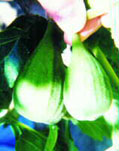| Beautiful,
voluptuous, and sweet to the taste, the first stories of figs trace back to biblical times. One of the first
fruits to be dried and stored by mankind, ancient cities dating
back to 600 BC include the fig in their folklore. Early Spanish
missionary fathers first planted fig trees in the San Diego Mission
in 1759, and were responsible for planting them at each succeeding
mission as they headed north. The fig was loved, desired, and
transported everywhere. However, it didn't thrive everywhere.
The fig loved the hot, dry, desert like climate of the San Joaquin
Valley the most.
stories of figs trace back to biblical times. One of the first
fruits to be dried and stored by mankind, ancient cities dating
back to 600 BC include the fig in their folklore. Early Spanish
missionary fathers first planted fig trees in the San Diego Mission
in 1759, and were responsible for planting them at each succeeding
mission as they headed north. The fig was loved, desired, and
transported everywhere. However, it didn't thrive everywhere.
The fig loved the hot, dry, desert like climate of the San Joaquin
Valley the most.
The black fig is known today as
the Mission fig, appropriately named during that particular
time in history. It's deep, rich purple color distinguishes it
from the other figs, yielding a pinkish flesh ranging from a watermelon
like color, to the deeper pink of a strawberry. It's distinctive
rich flavor is enhanced by the dry heat of California, and the
hotter the weather, the more luscious the fruit.
The golden brown Calimyrna fig,
was brought to California from Turkey in 1882, and also thrives
today in the San Joaquin Valley. It's yellow-green with white
fleck coloration produces a white meat, with an amber to light
strawberry textured like pulp.It also has
a rich, nutty flavor, sweet to the taste. It's nutty taste is
a direct result of caprification,* a pollination
process, unique to the samyrna type fig, of which the calimyrna
is part of. Each fig of this type will have a different taste
as a result of the caprification process, a little known fact,
apparent only when you are tasting figs in their fresh form.
The Kadota
fig is thick skinned and a little less seedy, because the seed
is hollow. Producing a stronger and more distinctive flavor than
its
counterparts, it is less crunchy
in texture. The Kadota fig is parthenocarpic . it does
not require pollination . therefore it is more consistent. |
Less
sweet than the other varieties, the darker yellowish green fruit
is shaped like a tear drop. Although it is used often as a canned
or stewed fruit, it is delightful to eat fresh.
We are speaking
of the taste of fresh figs, growing in California's San Joaquin
Valley, and the grower's are the DeBenedetto family, a three generation
family business of Italian descent, recognized as the premium
label in fresh figs.
Figs of the varieties
grown in California have always been able to be picked fresh.
However, the harvesting techniques required were different and
much more labor intensive. Within the confines of the fig growers,
it has always been known that fresh figs, picked at the height
of ripeness off the trees, are succulent, juicy, with heightened
flavors. However, in the early days of fig production, there were
some extra considerations.
Mauro, the Patriarch
of the family, along with a handful of growers in the San Joaquin
Valley, picked and packed fresh figs during the day, and transported
them without refrigeration to San Francisco by the next day. It
took careful planning to capture the premium fresh quality of
the fig. This was all accomplished during the depression. The
government was creating a guaranteed sale of dried figs to the
growers, by purchasing all unused dried fruit that was not sold
for consumption. They would then distill it to make alcohol, which
would then be made into fuel. There was little incentive to sustain
the labor intensive market of fresh figs during the course of
WWII.
The fresh figs,
however, tasted wonderful. Carefully handpicked and saved for
the families of the growers, fresh figs continued to be a "secret",
making its way to market by a very narrow, "niche" demand. The
average shelf life of the fresh fig is one of the shortest in
the industry, representing a 10 . 15 day shelf life, tops. It
must be picked at the height of its freshness, because it does
not ripen once it is picked. Compare this with other fruits of
the industry, with the delicate kiwis having one of the longest
shelf lives. |
